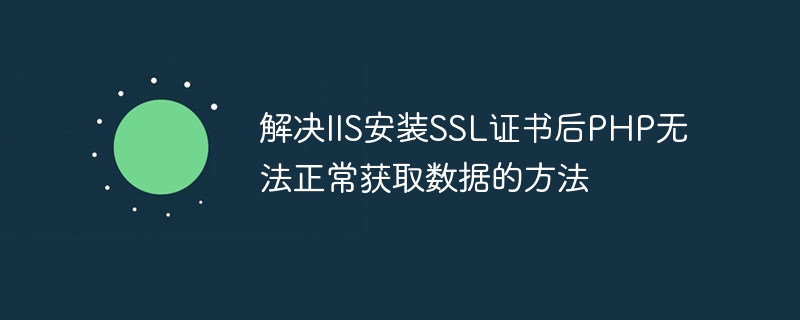

To solve the problem that PHP cannot obtain data normally after IIS installs an SSL certificate, specific code examples are needed
With the improvement of Internet security awareness, more and more websites Start using SSL certificates to encrypt data transmission and protect user privacy and information security. On the Windows platform, one of the commonly used web servers is IIS (Internet Information Services). However, some developers find that PHP cannot obtain data normally after installing the SSL certificate and may encounter some problems. This article explains how to solve this problem and provides specific code examples.
First, make sure that the SSL certificate is correctly configured on IIS. This includes installing the certificate on the server, configuring binding information, ensuring the certificate chain is complete, etc. If the SSL certificate is configured incorrectly, it may cause PHP to have errors when communicating with the server.
Open the PHP configuration file php.ini, find the following lines of configuration, and make sure it is configured correctly:
;extension=php_openssl.dll ;extension=php_curl.dll
Remove the semicolon and ensure that these two extension modules are enabled. These two modules are responsible for handling SSL connections and HTTPS requests in PHP and must be ensured to work properly.
When using HTTPS requests in PHP, make sure to use the correct HTTPS request path, that is, a URL starting with https://. Otherwise, PHP may not correctly recognize that the request is for a secure connection.
The following is a simple sample code that uses the cURL library to send an HTTPS request:
<?php
$url = "https://example.com/api/data"; // 替换成实际的HTTPS接口地址
$ch = curl_init();
curl_setopt($ch, CURLOPT_URL, $url);
curl_setopt($ch, CURLOPT_RETURNTRANSFER, true);
$result = curl_exec($ch);
if(curl_errno($ch)){
echo 'Curl error: ' . curl_error($ch);
}
curl_close($ch);
echo $result;
?>This code sends a request to the specified HTTPS interface through the cURL library and obtains the returned data. Make sure to replace $url with the actual HTTPS interface address when actually using it.
Sometimes, the reason why PHP cannot obtain data normally may be because the SSL certificate verification fails. If certificate verification fails, it may be because the server certificate is not trusted by PHP. This problem can be solved by adding the SSL verification option to the cURL request. The sample code is as follows:
curl_setopt($ch, CURLOPT_SSL_VERIFYPEER, true); curl_setopt($ch, CURLOPT_SSL_VERIFYHOST, 2);
These two lines of code respectively indicate enabling verification of the SSL certificate and setting up host name verification. Ensure that these two options are configured correctly to avoid data acquisition problems caused by SSL certificate verification failure.
Through the above method, you can solve the problem that PHP cannot obtain data normally after installing the SSL certificate in IIS. The key is to ensure that the SSL certificate is configured correctly, the SSL extension module in PHP is enabled, and the correct HTTPS request path is used. At the same time, when sending HTTPS requests through the cURL library, be sure to add the SSL certificate verification option to effectively avoid problems caused by SSL certificate verification failure. Hopefully these methods and code examples will help you solve this problem.
The above is the detailed content of How to solve the problem that PHP cannot obtain data normally after IIS installs the SSL certificate. For more information, please follow other related articles on the PHP Chinese website!
 IIS unexpected error 0x8ffe2740 solution
IIS unexpected error 0x8ffe2740 solution
 flac format
flac format
 What are the e-commerce platforms?
What are the e-commerce platforms?
 The difference between ++a and a++ in c language
The difference between ++a and a++ in c language
 Where should I fill in my place of birth: province, city or county?
Where should I fill in my place of birth: province, city or county?
 What is the difference between 5g and 4g
What is the difference between 5g and 4g
 How to use btbook magnetic search
How to use btbook magnetic search
 How to configure the path environment variable in java
How to configure the path environment variable in java




